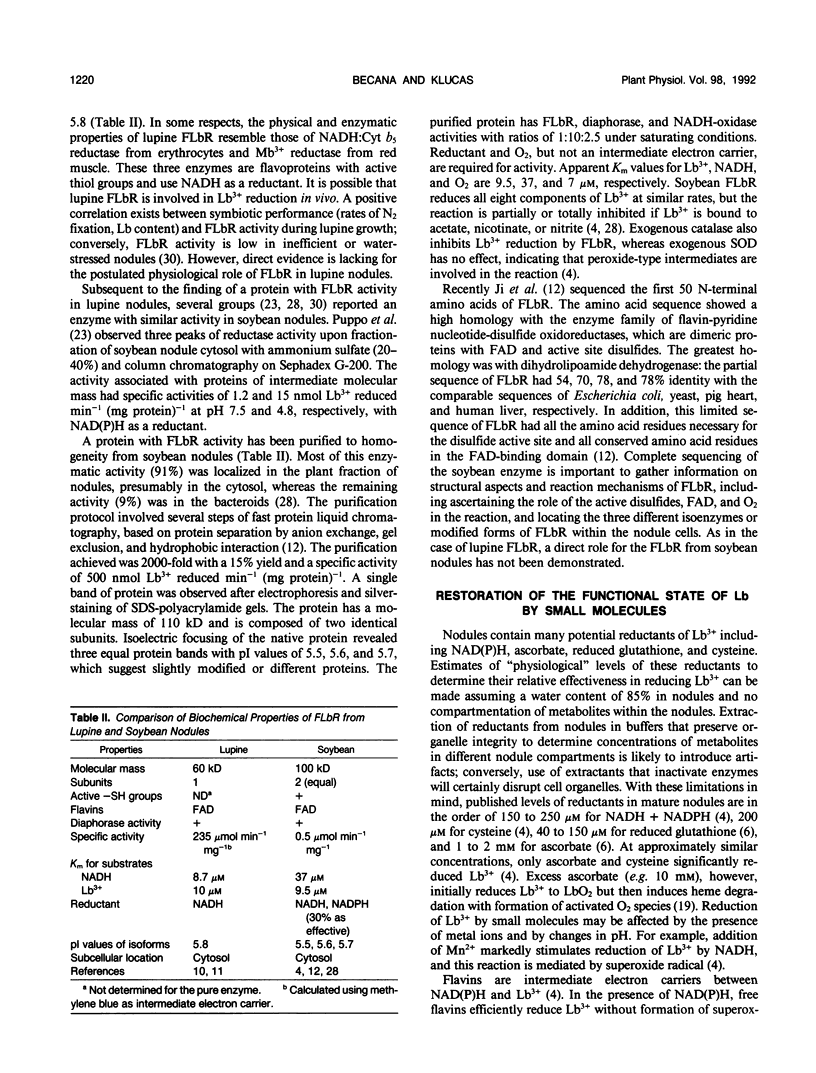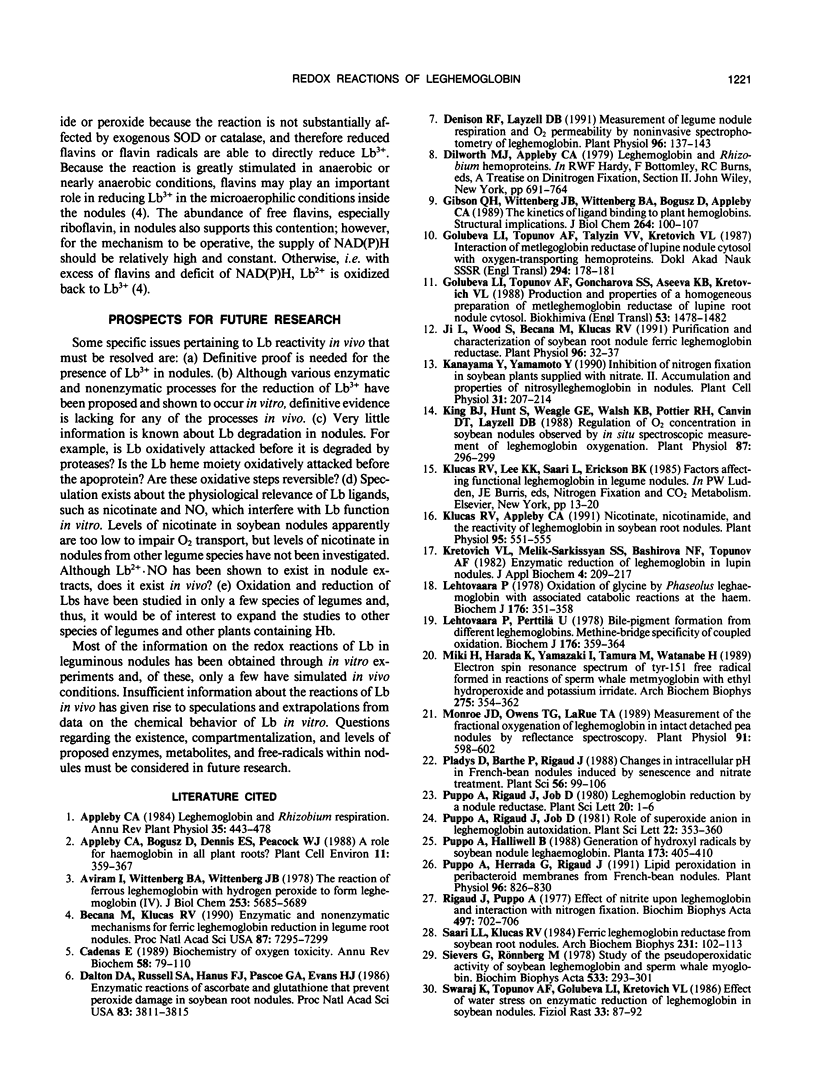Abstract
Reactions involving changes that affect the function of leghemoglobin (Lb) are reviewed. The chemical nature of Lb and conditions inside nodules, such as slightly acid pH and the presence of metal ions, chelators, and toxic metabolites (nitrite, superoxide radical, peroxides), are conducive for oxidation of ferrous Lb (Lb2+) or its oxygenated form (LbO2) to nonfunctional ferric Lb (Lb3+) and ferryl Lb. Because Lb3+ is nearly nonexistent in nodules and undergoes observable reduction in vivo, mechanisms must operate in nodules to maintain Lb in the Lb2+ state. Redox reactions of Lb are mediated, for the most part, by activated oxygen species: (a) oxidation of LbO2 to Lb3+ involves superoxide; (b) excess peroxide oxidizes LbO2 and Lb3+ to ferryl Lb and may cause breakdown of heme, release of iron, and generation of hydroxyl radicals (protein radicals may be formed in this process); (c) enzymatic reduction of Lb3+ requires active flavin and thiol groups and involves formation of peroxide; and (d) direct reduction of Lb3+ by NADH is mediated by superoxide and peroxide. Transition metal ions and certain small molecules of nodules such as flavins may act as intermediate electron carriers between NADH and Lb3+, increasing the rate of reaction, which then proceeds via superoxide or flavin radicals, respectively.
Full text
PDF




Selected References
These references are in PubMed. This may not be the complete list of references from this article.
- Aviram I., Wittenberg A., Wittenberg J. B. The reaction of ferrous leghemoglobin with hydrogen peroxide to form leghemoglobin(IV). J Biol Chem. 1978 Aug 25;253(16):5685–5689. [PubMed] [Google Scholar]
- Becana M., Klucas R. V. Enzymatic and nonenzymatic mechanisms for ferric leghemoglobin reduction in legume root nodules. Proc Natl Acad Sci U S A. 1990 Sep;87(18):7295–7299. doi: 10.1073/pnas.87.18.7295. [DOI] [PMC free article] [PubMed] [Google Scholar]
- Dalton D. A., Russell S. A., Hanus F. J., Pascoe G. A., Evans H. J. Enzymatic reactions of ascorbate and glutathione that prevent peroxide damage in soybean root nodules. Proc Natl Acad Sci U S A. 1986 Jun;83(11):3811–3815. doi: 10.1073/pnas.83.11.3811. [DOI] [PMC free article] [PubMed] [Google Scholar]
- Denison R. F., Layzell D. B. Measurement of legume nodule respiration and o(2) permeability by noninvasive spectrophotometry of leghemoglobin. Plant Physiol. 1991 May;96(1):137–143. doi: 10.1104/pp.96.1.137. [DOI] [PMC free article] [PubMed] [Google Scholar]
- Gibson Q. H., Wittenberg J. B., Wittenberg B. A., Bogusz D., Appleby C. A. The kinetics of ligand binding to plant hemoglobins. Structural implications. J Biol Chem. 1989 Jan 5;264(1):100–107. [PubMed] [Google Scholar]
- Ji L., Wood S., Becana M., Klucas R. V. Purification and characterization of soybean root nodule ferric leghemoglobin reductase. Plant Physiol. 1991 May;96(1):32–37. doi: 10.1104/pp.96.1.32. [DOI] [PMC free article] [PubMed] [Google Scholar]
- King B. J., Hunt S., Weagle G. E., Walsh K. B., Pottier R. H., Canvin D. T., Layzell D. B. Regulation of o(2) concentration in soybean nodules observed by in situ spectroscopic measurement of leghemoglobin oxygenation. Plant Physiol. 1988 Jun;87(2):296–299. doi: 10.1104/pp.87.2.296. [DOI] [PMC free article] [PubMed] [Google Scholar]
- Klucas R. V., Appleby C. A. Nicotinate, nicotinamide, and the reactivity of leghemoglobin in soybean root nodules. Plant Physiol. 1991 Feb;95(2):551–555. doi: 10.1104/pp.95.2.551. [DOI] [PMC free article] [PubMed] [Google Scholar]
- Lehtovaara P. Oxidation of glycine by Phaseolus leghaemoglobin with associated catabolic reactions at the haem. Biochem J. 1978 Nov 15;176(2):351–358. doi: 10.1042/bj1760351. [DOI] [PMC free article] [PubMed] [Google Scholar]
- Lehtovaara P., Perttilä U. Bile-pigment formation from different leghaemoglobins. Methine-bridge specificity of coupled oxidation. Biochem J. 1978 Nov 15;176(2):359–364. doi: 10.1042/bj1760359. [DOI] [PMC free article] [PubMed] [Google Scholar]
- Miki H., Harada K., Yamazaki I., Tamura M., Watanabe H. Electron spin resonance spectrum of Tyr-151 free radical formed in reactions of sperm whale metmyoglobin with ethyl hydroperoxide and potassium irridate. Arch Biochem Biophys. 1989 Dec;275(2):354–362. doi: 10.1016/0003-9861(89)90382-2. [DOI] [PubMed] [Google Scholar]
- Monroe J. D., Owens T. G., Larue T. A. Measurement of the fractional oxygenation of leghemoglobin in intact detached pea nodules by reflectance spectroscopy. Plant Physiol. 1989 Oct;91(2):598–602. doi: 10.1104/pp.91.2.598. [DOI] [PMC free article] [PubMed] [Google Scholar]
- Puppo A., Herrada G., Rigaud J. Lipid peroxidation in peribacteroid membranes from French-bean nodules. Plant Physiol. 1991 Jul;96(3):826–830. doi: 10.1104/pp.96.3.826. [DOI] [PMC free article] [PubMed] [Google Scholar]
- Rigaud J., Puppo A. Effect of nitrite upon leghemoglobin and interaction with nitrogen fixation. Biochim Biophys Acta. 1977 May 26;497(3):702–706. doi: 10.1016/0304-4165(77)90291-4. [DOI] [PubMed] [Google Scholar]
- Saari L. L., Klucas R. V. Ferric leghemoglobin reductase from soybean root nodules. Arch Biochem Biophys. 1984 May 15;231(1):102–113. doi: 10.1016/0003-9861(84)90367-9. [DOI] [PubMed] [Google Scholar]
- Sievers G., Rönnberg M. Study of the pseudoperoxidatic activity of soybean leghemoglobin and sperm whale myoglobin. Biochim Biophys Acta. 1978 Apr 26;533(2):293–301. doi: 10.1016/0005-2795(78)90376-8. [DOI] [PubMed] [Google Scholar]


